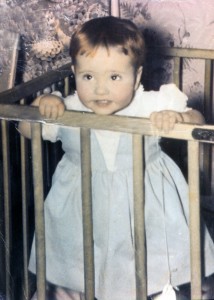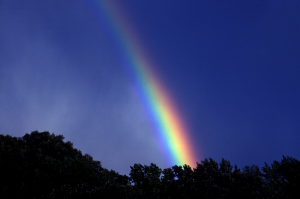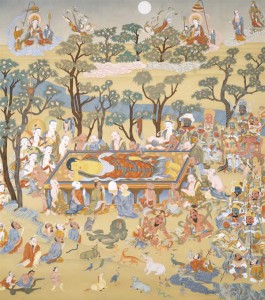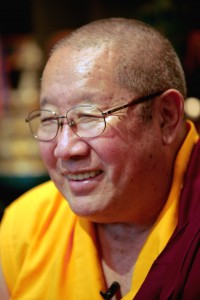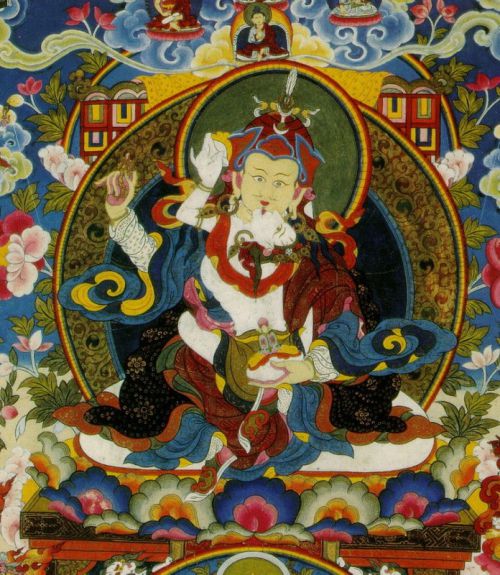 anisonam
anisonam
Miraculous Signs: The Birth of Jetsunma Ahkon Lhamo
The following story was told by Jetsunma Ahkön Lhamo in response to repeated requests by her students:
Well, this is the story that my mother told me about the time of my birth. And I feel certain that it is true because she didn’t know what any of it meant and was reporting it like a person who didn’t understand. She told me that it actually took three days for me to be born, which is kind of interesting. I’m sure it set off the groundwork for a great mother-daughter relationship, but she told me that it took three days for me to be born. Whenever it seemed as though the contractions were getting stronger, I would go back up again, and they had a hard time delivering me.
It turns out that I was in a breach position, which is common for tulkus; but uniquely when I was delivered, what was delivered first was my bottom with crossed legs. My mother said it was really crazy because my feet were locked up. From what I am able to understand, I was born in a lotus position. So it was very difficult to deliver the bottom part with the legs. The total mass would have been bigger than the head. I think that is why the delivery was so difficult. But I was born in that position and my hands were in an interesting position as well. My mother said they thought I had a pulled nerve in my left arm because my hand was like this (Tara mudra) and they couldn’t move it. They couldn’t budge it at all. And my other hand was like this (Tara mudra), which they thought was normal. But they could not move my hands, and they could not get me out of that position for some time. I think my hands stayed up for three days.
They thought I was a very sickly baby, and I think I was because I was hard to rouse—I think I was meditating. I was hard to rouse and difficult to get into another position. It was kind of unusual. I was born in the lotus position with the hands in Tara’s posture, and I had a zen [the upper robe worn by monks and nuns]. I was delivered with the caul or afterbirth partially on my body, and it was under my right arm and thrown up over my left arm. It was exactly like a zen.
What else? When I was born, my mother said that after the birth took place, the whole room filled up with the scent of flowers. And all the nurses and the doctor were just, “Where’s it coming from? Where’s it coming from?” And for some reason, everyone in the room cried, and they didn’t really know why they cried. They just cried. So, it was kind of amazing.
Understanding the Faults of Samsara: by Khenchen Tsewang Gyatso
The following is an excerpt from a teaching by Khenchen Tsewang Gyatso given at Kunzang Palyul Choling on Ngondro:
When contemplating the faults of samsara, we need to understand that in samsara, as we explained, there is some enjoyment, some peace, which distracts our minds and keeps us from having any accumulation of merit or purification. It is just like in Christianity: In the beginning, God said there is a very nice apple tree, but you should not get distracted and eat of it. If you do, then you will get spoiled. By not listening to that and eating the apple, all evil and bad things happened. Just like that, in this world there are certain things that really feel attractive, but when you look at the object of attraction and really examine it deeply, there is nothing attractive. It is all just like a magician’s creation which looks very real, but when you approach it, then you see that it is artificial with no essence. That is why one has the thoughts of the precious human birth, that death is uncertain, that the law of karma is going to direct you, and that the law of karma is created by yourself. There is no external law of karma ordering you to do all these kinds of things. Each and every experience of good and bad, suffering and happiness, that you experience each and every moment is created by yourself. That is known as the ripening of karma.
So we need to understand the fault of samsara. When one has a clear understanding of these four thoughts, you could have some kind of feeling that you have to do some practice. Samsara looks so attractive, but it doesn’t have any essence, like the rainbow. The rainbow looks so colorful, so nice, and you have so much desire and attachment. You really want to have it, but when you jump up to get it, you cannot get anything. Then you feel very sad, and you get so depressed. Why can’t I have some of this beautiful rainbow? You get upset, but nothing happens. All these worldly pleasures are exactly like a rainbow. When you really enter into them, there is nothing there to have. That is why one must have a deeper understanding of cyclic existence. Then you can become more relaxed and have more enjoyment, thinking how attractive everything is, but having no attachment to it, no desire. You can enjoy and at the same time not create any negative karma and be more relaxed, because you don’t have to try to get anything. Whether you get something or not, you just relax. If you can’t get it, you won’t feel depressed because you know that it has no essence.
So your mind gets very relaxed, you can enjoy whatever happens without any attachment or afflicted mind. In that way, one can have a very smooth life without any depression or emotional feelings and without any excitement, but still some kind of enjoyment is always there. That is how we can really apply practice into our daily life—just relaxing, no attachment, no hatred or anger, just always relaxed and balanced. Whatever things you have, you enjoy them just like a magician’s creation.
At the same time, you do not have any attachment to the practices. No attachment to the Great Perfection ngöndro practice. Attachment binds you; it is a type of bondage. When you feel that kind of excitement, like, “Oh, I want to do this ngöndro practice. This is so great!” with so much expectation and so much interest, then as you apply it into practice, some obstacle arises. Then you feel like you should have gone some other place for the weekend. “I should have gone to see my friends or relatives.” When one has so much attachment or expectation, that also becomes an obstacle. So you need to get relaxed, always get relaxed, thinking this is a great opportunity.
Meditation

This is a guided meditation by Jetsunma Ahkon Lhamo. In a teaching from the 1980s, Jetsunma taught about how this meditation helps one get passed the feeling of separation, and begin to imitate the radiant qualities of one’s true nature – light and compassion.
In her words, “Separation is the cause of all trauma, all pain, any grief that you have ever suffered anywhere, or at anytime. Anything that has ever hurt you or been a bother to you has been because you believe yourself to be separate from everything. Your true nature is Absolute Union or Oneness. The true nature that you are is light.
Effective prayer is about imitating that radiance. Through imitation of your true nature, you come to realize your true nature. You stop thinking about separation, and you stop buying into judgment, and you get out of limitations. Effective prayer is centering into that Absolute reality that is the core of what you are.”
How to Handle the “Dead Zone”
The following is an excerpt from a teaching by Jetsunma Ahkon Lhamo called “Marrying Spiritual Life with Western Culture”
So ask yourself, where are you? If you find that deadness inside of you, don’t blame your path, don’t blame your teacher, don’t blame your society, don’t blame the Buddha. Instead, go within and find what is true and meaningful to you. Work the sums. Reason it out. Lord Buddha himself said, “Forget blind faith.” He said, “Reason it out.” The path should make sense. It should be logical and meaningful to you, not to me. What’s it going to mean to you if it’s meaningful to me? It has to be logical and meaningful to you. This is what the Buddha said. It would really help you to try that out for yourself.
We live in a society where we are separate from some fundamental life rhythms and where we are trained to think that things are happening outside of us. We’re in a world filled with terrorism and racial abuse, religious abuse, all kinds of conflict, and yet we think racial intolerance, for instance, is happening out there. We read about it in the paper. No, racial intolerance is happening in here. That’s where it’s happening.
It’s like that with everything on this path. You cannot let it happen out there. It’s your responsibility, your empowerment, your life. Waiting for someone to tell you how to live it is not going to fly. When you walk on a spiritual path that you know, that you have examined, that you have given rise to understanding, you draw forth your natural innate wisdom. That fills your heart with a sense of truth because you understand it—not because someone else does. That’s the way to do it, and that’s what the Buddha recommended. In fact, he said, “I’ve given you the path. Now work out your own salvation.”
That wasn’t just a flip thing. When people hear that they go, “It’s such a cool thing that he said that! He must have had a great sense of humor.” He meant it! The path is there, but you’ve got to work it out. That’s how you walk on the path. Otherwise you’re walking alongside the path. Then you’re a friend of Dharma, an admirer of Dharma, but not a practitioner—even if you wear the robes.
So handle the dead zone. Empower yourself. There is no reason why you can’t. Don’t live your life by “bash-to-fit, paint-to-match.” Don’t do that. You are alive. In every sense, your nature is the most vibrant force in the universe, the only force in the universe. It is all there is. To play this game of duality where you stand outside your own most intimate experience and like a sheep get led through your life, that is not the way to go.
Many of you came to this path from another path because you felt dead there. But remember this: Wherever you go, there you are. You brought the deadness with you. So handle it.
I hope that you really, really take this teaching to heart because it’s really an important thing. If I had one gift that I could give you all, it would be to stay alive in your path, to have your spiritual life be like a precious jewel inside of you, living, something to warm you by. If life took everything else away from you, which it will eventually, this is the thing that cannot be taken.
Copyright © Jetsunma Ahkon Lhamo. All rights reserved
The Path to Ultimate Happiness: Advice from His Holiness Penor Rinpoche
The following is an excerpt from advice offered by His Holiness Penor Rinpoche during the New York Retreat in 2005:
Now we have this Precious Human Birth it is very important that we do something about it. Whatever kind of aspiration or attainment that we may achieve in this life, the only thing that really counts is what we do in this present time. At the end when we die, we can take nothing with us. Even though a person may have wealth comparable to that of the USA, he is unable to take even a small needle with him when he dies. When our time comes, we have to leave our spent body behind. If you have been practicing Dharma, then Dharma is the only thing you can take with you. But if you have committed non-virtue then the karma you generated through that will be the only thing you can take with you. Whether this is true or not, all you have to do is to reflect upon it thoroughly, then you will know for certain how true it is.
For this reason, it is very important to have faith in Dharma and practice accordingly. If you have doubts about the practice, then you can gain nothing from it. If you practice Dharma without doubt and with wisdom, then only positive results will ripen up for you. Buddhist Dharma has many special qualities; in particular, the practices in which you have just joined this year are part of the practice of Dzogpa Chenpo, which belong to the most supreme, most precious part of Dharma practice.
It is very difficult to practice Dharma due to the karmic and emotional defilements which keep us attached to the mundane worldly kind of existence, it is as if you have to climb a mountain with a burden of heavy baggage on your back. You have to undertake a very long and arduous journey in your Dharma practice, but it is very easy for you to lose your footing and fall down on the way. Furthermore your fall back down again will be very swift, much swifter and further than for those who do not carry much of this kind of baggage. When you climb up a steep mountain, it is very difficult and very tiring, similarly the practice of Dharma is also challenging. To reach the ultimate happiness you have to maintain Dharma practice diligently. When you practice Dharma, you have to abandon any doubts and practice it with a single-pointed mind. There is no need to have doubt concerning Dharma because, since time without beginning, an ocean of practitioners has already attained enlightenment through this kind of practice.
These people also had the strong wish to attain happiness and they put all of their efforts into the practice. You only have to listen to what they have achieved, to realise the vast number of realised masters who have already succeeded in their endeavour to achieve lasting happiness and realisation. For you, it is impossible to actually check the nature of the qualities of Dharma, to judge whether they may be good or bad. If you possessed qualities higher than those of Guru Padmasambhava or Lord Buddha, then you might have a more objective view of the qualities of Dharma. At the moment it is impossible for you to have such an objective perspective, for it is no different from a blind person who says he wants to visually check his own body – how is it possible? Instead of having doubt in Dharma, it is better to have faith and trust and to practice as much as you can.
Calling to the Guru – Yeshe Tsogyal
The following is an excerpt from Mother of Knowledge translated by Tarthang Tulku
Yeshe Tsogyal is calling out to Guru Rinpoche as he prepares to leave Tibet to tame the land of savages:
The sun that warms the land of Tibet,
shining over both gods and men, has set.
Now who will warm us, who are totally naked?
The luckless Tibetans have lost their eyes.
Now who will lead us, who are blind and alone?
Our hearts have been torn from our breasts.
Now who will guide the mindless corpses?
You came here to benefit beings.
Why couldn’t you stay just a little while longer?
Kye Hud! Orgyan Rinpoche!
A time of thick darkness has come to Tibet:
A time when hermitages are empty;
a time when the Dharma throne is vacant;
a time when vase initiations are no more.
Now we can only guess as to the nature of the teachings;
now we must look to books for teachings;
now we can only visualize the lama;
now we must use images as his substitute;
now we must rely on dreams and visions;
now a grievous time has come!
Precious Human Rebirth – YouTube Video
Precious Human Rebirth: YouTube video teaching by Jetsunma Ahkon Lhamo:
Mind Creates Form: Khenpo Tenzin Norgay
The following is an excerpt from a teaching by Khenpo Tenzin Norgay given at Kunzang Palyul Choling called “The Six Paramitas”
We are always concerned about our mind. We have the body, speech and mind, and according to our Buddhist teachings, we say that our mind is more powerful than our body and speech. It is the main controller. Once we have our mind controlled, then our body becomes naturally controlled, and then our speech is also perfected. So that’s why, instead of making our body perfect, what we are doing is making our mind perfect.
The mind is given more importance in our teachings. According to our teachings, our mind can create a physical object, not the other way around—a physical object creating our mind. So this is one of the main teachings. If we are able to understand that, then the law of karma, or incarnation, can be better understood.
So here, when we say our mind can create physical objects or all these projections—it is in the Abhidharma teachings—we are talking about how we have three realms of existence: the formless realm, the form realm and the desire realm. Even in the Sutrayana teachings, when talking about, the formation of these three realms or cyclic existence, like when earth or some physical formation is there, it’s saying that it starts from below and then goes upward—having this sphere and space and the sphere of water and all gradually stacking upward. Then when talking about the formation of the beings abiding there, the inhabitants, it’s talking about stepping downward. First we can say we have this formless realm where there is only consciousness. The person born in the formless realm is, in one way of saying, less distracted and has a great degree of meditation but without Vipassana or Right View. If we don’t have Right View, then when our meditational power becomes exhausted, we can be born in the form realm. In the form realm, our teachings say, there is no physical body of flesh and bones, but not exactly the rainbow-like body. So there is sort of like a physical body there which is not really made of flesh and bones. But it’s saying because of our attachment to the physical form, there is some solid form of physical appearances in the form realm. When this becomes stronger, we call it the desire realm. So that’s where we are, in this desire realm. And here, our desire to objects is stronger, so we have this flesh and bones and this brain.
What I’m trying to say is our mind can exist freely without relying upon the chemicals in our brain. If it were just a chemical process, then once the brain died, everything would be dead. So it seems this is not our teaching. Our teaching is that our mind creates the brain, not the brain creates our mind.
28th Anniversary of the Enthronement of Jetsunma Ahkon Lhamo
The lowing of the conch shell sounded from various points on the temple grounds like a soft foghorn. It overlaid the patter of hammers as stupa construction continued. Sometimes the sound wavered and spluttered out, and Jetsunma would laugh, lowering the conch. She was practicing for the enthronement ceremony the following day and had been told at the last minute that she would have to blow the conch. She never had before, at least not in this lifetime. She wiped her mouth and joked to her students, “I’m never going to get this down.”
She gamely tried again, continuing her gradual circumambulation of the temple. The sound came out clear and strong and hung in the air. After a moment of stillness, the students cheered.
On September 24, 1988, the temple filled with cameras and mics angled in every direction. Jetsunma sat quietly humble on the throne, and straightened the brocades draped over her shoulders, blinking at the lights. The temple had never been so brightly lit. To the blare of Tibetan horns and ringing bells, NBC filmed while His Holiness Penor Rinpoche, Throne Holder to the Palyul Lineage of the Nyingma School of Vajrayana Buddhism, formally enthroned Jetsunma Ahkon Lhamo as a tulku, or reincarnate teacher.
According to tradition, ceremonial items were carried from H.H. Penor Rinpoche to Jetsunma, empowering her to teach and formally represent the Palyul Lineage. When the time came for her to blow the conch on camera, the sound came clear and then wavered. Not as good as the night before. She shared a wry smile with her students, tipping her head, Oh well. Then one of the monks had to blow the conch. His Holiness chuckled and Gyaltrul Rinpoche translated his comment, “They should have had Jetsunma do it.”
The news spread via Associated Press, and world newspapers printed photos of the spectacle of a western woman with long dark hair on a Tibetan throne. Her enthronement came at a time when Vajrayana Buddhism was relatively unknown in the US. The year before, an obscure Tibetan monk, H.H. the Dalai Lama, spoke at the National Cathedral to a scattered audience of about a hundred. At Buddhist temples in the late 1980s, teachers were universally Asian.
It was openly questioned whether westerners could accomplish this eastern religion.
H.H. Penor Rinpoche, who never shirked what was needed, answered with a resounding yes. As he enthroned her, he said, “People have asked me why there are no American tulkus. And people have asked me why there are no female Lamas. Now you have both. So you should be very happy.”
“This is for you,” Jetsunma said later to her students. “It’s for all of us really. This is your own enthronement, your own future accomplishment that you’re seeing.” She explained that the enthronement meant that not only can Dharma be accomplished, it can be accomplished by westerners, even in this day and age. “Yes, even you.” And she wrinkled her nose impishly at her students, and laughed.
Post written by Michelle Grissom
